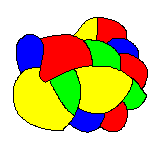Topology F Continuous F1 of a Intersect B
The whole point of this article is the following seemingly trivial observation.
Theorem. A topological space X is compact if and only if it satisfies thefinite intersection property (F.I.P.):
Proof.
SupposeX is compact. Then given a collection {Ci } of closed subsets ofX with empty intersection, we have so the open cover {X–Ci } has a finite subcover. This gives a finite collection of Ci with empty intersection.
The converse is just as easy: if F.I.P. holds and is an open cover of X, then
By F.I.P., there's a finite collection
so
is a finite subcover. ♦
Though this looks like a simple rephrasing of the definition of compact spaces, its underlying philosophy embodies an entire paradigm shift. [ Ok, that's probably stretching it a little … ] The idea is that a closed subset ofX typically represents a subset which satisfies certain nice conditions. Hence F.I.P. means that if every finite set of conditions can be satisfied by some object, then there's some object that satisfies all conditions.
To make it a little more explicit, let's prove the following.
Proposition. Suppose
are non-empty compact Hausdorff spaces and
is a collection of continuous maps:

Then there exists a sequence
where
and
for each n≥1.
Compactness is essential here. For example, if and eachfn is the inclusion map, then no such sequence exists since the intersection of allX>n is empty.
Proof.
Let which is compact by Tychonoff's theorem. For eachn≥1, let:
Note that Also
is homeomorphic to
via the following mutually inverse maps:
Thus is non-empty and compact. Since X is Hausdorff,
is closed in X . By F.I.P.,
♦
In particular, ifXn is finite with the discrete topology, then it's compact Hausdorff and any mapfn is continuous.
Corollary. If
is a sequence of non-empty finite sets and
is a collection of functions, then we can find
such that
for each n≥1.
Once again, a deceptively simple result. It looks obvious until one really attempts to prove it. [ Try proving it directly; bear in mindfn is not surjective in general. ]

Application: Infinite Four-Colour Theorem
We know the four-colour theorem for maps with finitely many countries, namely, any such map can be coloured by at most four colours such that no two countries which share a border have the same colour.

What about a map with countably infinite number of regions? It's not entirely clear that four colours suffice. One may be inclined to reason as follows: start with a region with finitely many countries – we know this can be coloured by four colours – then extend the colouring to other countries one at a time. The problem with this approach is that if we start with a bad colouring, then we may get stuck and be forced to retrace the steps, and how do we prove that retracing the steps must eventually lead to a valid colouring?
Compactness to the rescue.
Label each country as 1, 2, 3, … . LetXn be the set of colourings of the map restricted to countries 1, …, n, with 4 colours such that two countries which share a border do not have the same colour. We have a map by ignoring the colour of then-th country.

Now, classical four-colour theorem tells us eachXn is non-empty. So by the above corollary, there's a sequence with
such that
for each n. This corresponds to a colouring for the entire infinite map. ♦
Application: Infinite Tiling
Suppose we wish to fit a countably infinite set of shapes in a bounded region.

Now we assume that every finite subset of shapes can be fitted within the bounded region without overlaps. [ We say that two shapes overlap if their interiors share a common point. Also a shape is within the bounded region as long as its interior is inside. ]
Claim. Under this assumption, the entire infinite class of shapes can be placed in the region without overlaps.
Proof.
Label the shapes by 1, 2, 3, … . For eachn, letXn be the set of ways to fit shapes 1 ton within the region. The map is given by removing shapen.

The placement of each shapei can be parametrised by coordinates and a point on the unit circle representing its orientation. ThusXn can be parametrised by 2n coordinates andn points on the unit circle, which forms a subset ofR 4n . This subset is clearly bounded; it's also closed because its complement is open: e. g. if two shapes have overlapping interiors, then by perturbing all shapes a little, those two shapes still overlap. Thus, by the Heine-Borel theorem,Xn is compact. The above proposition tells us there's a way to fit all shapes in. ♦
Note
Suppose we change the condition of overlap just a little: now two shapes are said to overlap if there's a common point (even at the boundary). Then consider rectangles 1 × 2–n , forn = 1, 2, 3, … , to be packed in the square 1 × 1. Since there's a way to pack every finite set of rectangles in the square, but if we attempt to pack the entire infinite set, some of them must share an edge and thus overlap.
Source: https://mathstrek.blog/2013/02/28/topology-finite-intersection-property-omake/